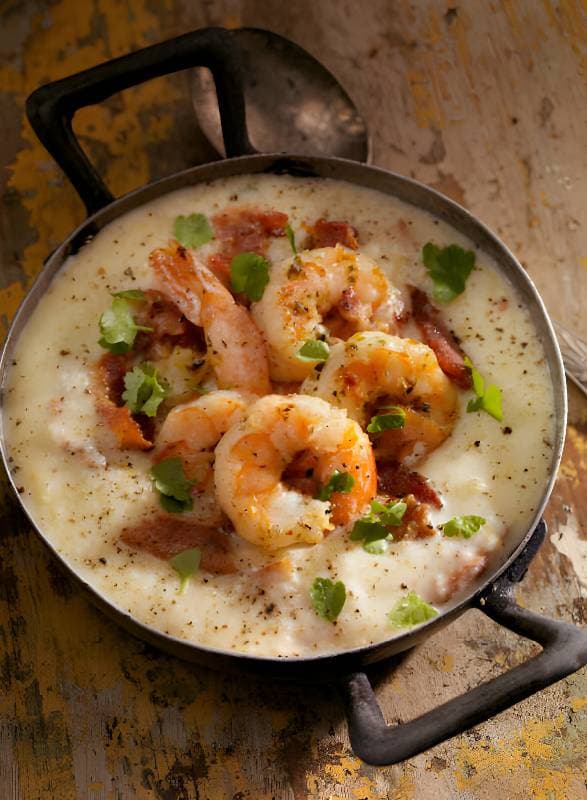Diving into the heart of Southern cuisine, we’re about to embark on a culinary journey that marries the soulful warmth of grits with the hearty embrace of pan-fried fish.

This isn’t just a meal; it’s a narrative of flavors, traditions, and innovations that have simmered together over generations. Today, we’re not just sharing a recipe; we’re weaving a tapestry of taste that highlights the rich cultural tapestry of the South. So, buckle up, dear reader, as we embark on this flavorful adventure, exploring every nook and cranny of the beloved Fish and Grits recipe.
Introduction to Fish and Grits
Ah, Fish and Grits, a dish that sings the song of the South with every bite. This isn’t just food; it’s a symphony of flavors, textures, and aromas that dance together in perfect harmony. But where did this iconic dish come from, and why has it nestled so firmly in the hearts (and stomachs) of so many?
The Roots and Routes of Fish and Grits
At its core, Fish and Grits is a testament to the ingenuity and resourcefulness of Southern cuisine. Grits, a dish of Native American origin, were adopted by European settlers and transformed into a staple of the Southern diet. Fish, on the other hand, was a plentiful resource in the coastal and riverine communities of the South. When these two were married, a star was born.
The dish has evolved over time, from a simple breakfast meal for fishermen to a gourmet delight that graces menus across the country. It’s a dish that carries the warmth of home, the richness of history, and the joy of a hearty meal shared with loved ones.
Variations on a Theme
Just as the South is a tapestry of cultures, so too are the variations of Fish and Grits. From the spicy, Creole-infused versions in Louisiana to the simpler, buttery renditions in the Carolinas, each variation tells a story. The fish, whether it’s catfish, trout, or snapper, is always the star, but the grits – oh, the grits – they’re the foundation that holds it all together, creamy and comforting.
In this exploration, we’ll dive deep into the heart of this beloved dish, uncovering the secrets to its preparation, the nuances of its flavors, and the joy it brings to tables across the South and beyond. So, let’s roll up our sleeves and get ready to cook, taste, and celebrate the glorious union of fish and grits.
Ingredients and Substitutes
Crafting the perfect Fish and Grits dish is akin to orchestrating a symphony. Each ingredient plays a crucial role, contributing its unique flavor and texture to the final masterpiece. Let’s dive into the ensemble of ingredients that make up this soulful dish, along with some clever substitutes to ensure everyone can enjoy this Southern classic, regardless of dietary restrictions or pantry limitations.
The Fish: The Star of the Show
The choice of fish is pivotal. Traditionally, catfish is the go-to for its flaky texture and mild flavor, which perfectly complements the creamy grits. However, the sea offers a bounty of options. Cod, sea bass, trout, grouper, and snapper also make excellent choices, each bringing its unique character to the dish. For those looking to keep it light and soft yet crisp on the outside, these alternatives are superb. And for the adventurous souls, a crispy breading can elevate the dish to new heights.
Substitutes: For folks with dietary restrictions or preferences, fear not. A variety of meaty options like bacon, ham, pork, chicken, and beef can stand in for fish. Seafood lovers can also explore shrimp, lobster, squid, oyster, and mussels as delightful alternatives.
The Grits: A Creamy Canvas
Grits are the heart and soul of this dish, a creamy canvas that absorbs and complements the flavors of the fish. Stone-ground grits are preferred for their coarse texture and ability to hold flavors and cheese beautifully. However, quick grits can be a time-saver for those in a rush.
Substitutes: For those who can’t find stone-ground grits or prefer a different base, polenta is an excellent alternative, offering a similar texture and flavor absorption. For a dairy-free version, consider using water or broth instead of milk and vegan cheese or nutritional yeast for that cheesy goodness.
The Sauce: The Flavor Enhancer
A good sauce can transform Fish and Grits from great to unforgettable. A tomato-based sauce with bell peppers, garlic, and Creole seasoning adds depth and a hint of spice. The sauce’s complexity is enhanced by the sweetness of the tomato and the rich umami of chicken broth.
Substitutes: For those looking to tweak the sauce to their liking or dietary needs, vegetable broth can replace chicken broth, and various seasoning blends can adjust the spice level. For a fruitier twist, consider adding lemon juice or a splash of apple cider vinegar.
Bringing It All Together
With the right ingredients or their substitutes, Fish and Grits can be a versatile dish that accommodates various tastes and dietary needs. The key is to balance the flavors and textures, ensuring that each component shines without overshadowing the others.
In the next section, we’ll walk through the step-by-step process of bringing these ingredients together to create a dish that’s not just a meal, but an experience. Stay tuned as we delve into the art of preparing the fish, making the sauce, and cooking the grits to perfection.
Step-by-Step Cooking Guide
Now that we’ve gathered our ingredients and explored substitutes, it’s time to roll up our sleeves and dive into the cooking process. Preparing Fish and Grits is an art that combines simplicity with a touch of culinary finesse. Let’s break down each step, ensuring that even beginners can create a dish that’ll impress.
Preparing the Fish
- Seasoning is Key: Begin by lightly brushing your fish fillets with oil. Season generously with salt, pepper, and your choice of Blackened or Creole Seasoning. This not only adds flavor but also helps to achieve that desirable crust.
- Get the Pan Hot: Preheat a large, heavy skillet over medium heat. A hot pan ensures a good sear, locking in the flavors.
- Fry to Perfection: Add butter or oil to the pan, then place the fish fillets in. Fry for 3-4 minutes on each side or until they reach your preferred level of doneness. The goal is a crispy exterior with a tender, flaky inside.
Tip: For an extra crunch, consider adding a cornmeal or flour breading to your fish before frying.
Making the Sauce
- Foundation Flavors: After removing the fish, lightly clean the skillet. Add a bit more oil, then sauté garlic, diced tomatoes, and bell pepper. This creates a flavorful base for the sauce.
- Broth and Seasoning: Pour in chicken or vegetable broth, add a squeeze of lemon juice, and sprinkle in Creole Seasoning. Adjust the salt and pepper to taste. Let the sauce simmer until it thickens slightly, marrying all the flavors together.
Tip: If you’re looking for a bit more heat, don’t hesitate to add a dash of cayenne pepper or a few drops of hot sauce.
Cooking the Grits
- Creamy Beginnings: In a heavy saucepan, bring water, milk (or your chosen substitute), and a pinch of salt to a boil. Add a bay leaf for an aromatic touch.
- Whisk in the Grits: Slowly whisk in the stone-ground grits to avoid lumps. Reduce the heat to a simmer, stirring frequently, until the grits have absorbed the liquid and reached a creamy consistency, about 40-45 minutes.
- Finish with Flavor: Remove from heat and stir in unsalted butter and sharp cheddar cheese until melted and smooth. Adjust seasoning to taste.
Tip: If your grits are too thick or too runny, adjust by adding a bit more liquid or cooking a little longer, respectively.
Assembling the Dish
With all components ready, it’s time to assemble your Fish and Grits. Spoon a generous amount of creamy grits onto a plate or bowl, top with the fried fish, and ladle over the savory sauce. This dish is best enjoyed hot, allowing all the flavors to meld together beautifully.
Congratulations! You’ve just created a dish that’s not only a feast for the taste buds but also a warm hug for the soul. Fish and Grits is more than just food; it’s a celebration of culture, tradition, and the simple joys of cooking and sharing a meal. Enjoy the fruits of your labor, and remember, the best meals are those made with love and a dash of creativity.
FAQs
Diving into a dish as rich in flavor and history as Fish and Grits, it’s natural to have questions. Whether you’re a seasoned chef or a curious newcomer, there’s always more to learn. Let’s tackle some of the most frequently asked questions about this beloved Southern classic.
Can You Substitute Grits with Cornmeal?
Yes, you can substitute grits with cornmeal, though the texture and flavor profile will differ. Grits are coarser and can provide a creamier base for your dish. Cornmeal, on the other hand, will result in a finer, slightly different texture. Polenta, another ground corn product, is a closer substitute to grits in terms of coarseness and cooking method.
Stone Ground Grits vs. Quick Grits: What’s the Difference?
The main difference lies in processing and cooking time. Stone-ground grits are less processed, retaining more flavor and nutrients, and typically require longer cooking times to achieve their creamy texture. Quick grits have been further processed to reduce cooking time significantly. While convenient, they often lack the depth of flavor found in stone-ground grits. For an authentic Fish and Grits experience, stone-ground is the way to go.
What Do Grits Taste Like?
Grits have a mild, somewhat earthy flavor that makes them an excellent canvas for other ingredients. They’re known for their ability to absorb and complement the flavors they’re paired with, whether it’s the rich umami of cheese or the savory goodness of seasoned fish. The beauty of grits lies in their versatility, easily swinging from savory to sweet, depending on the preparation.
What to Serve with Cajun Fish and Grits?
While Fish and Grits is a hearty, stand-alone dish, it can be paired with a variety of sides to round out the meal. Consider adding a fresh, crisp salad to balance the richness, or some steamed green vegetables for a pop of color and nutrition. For a truly Southern experience, serve with a side of cornbread or hushpuppies. And don’t forget the hot sauce on the table for those who like it spicy!
Fish and Grits is more than just a meal; it’s a culinary journey through the heart of Southern cuisine. With each bite, you’re not only enjoying a delicious dish but also partaking in a rich cultural tradition that spans generations. Whether you stick to the classic recipe or make it your own with substitutions and variations, the key is to cook with passion and enjoy the process. Happy cooking!


